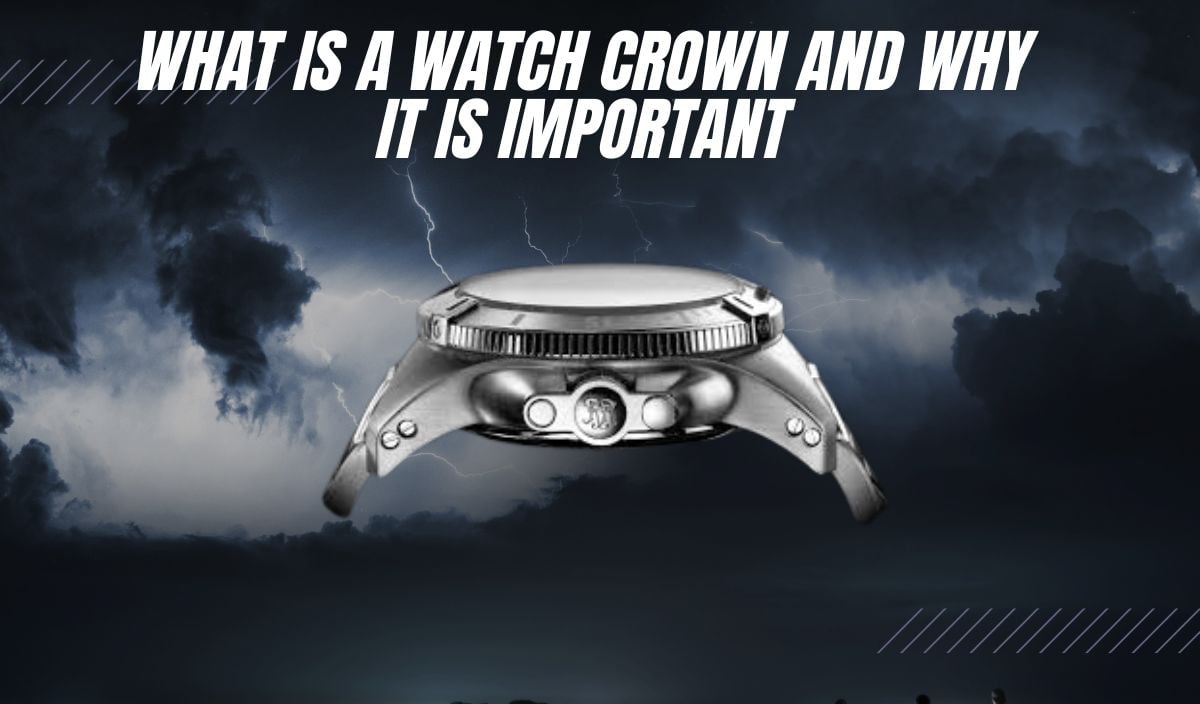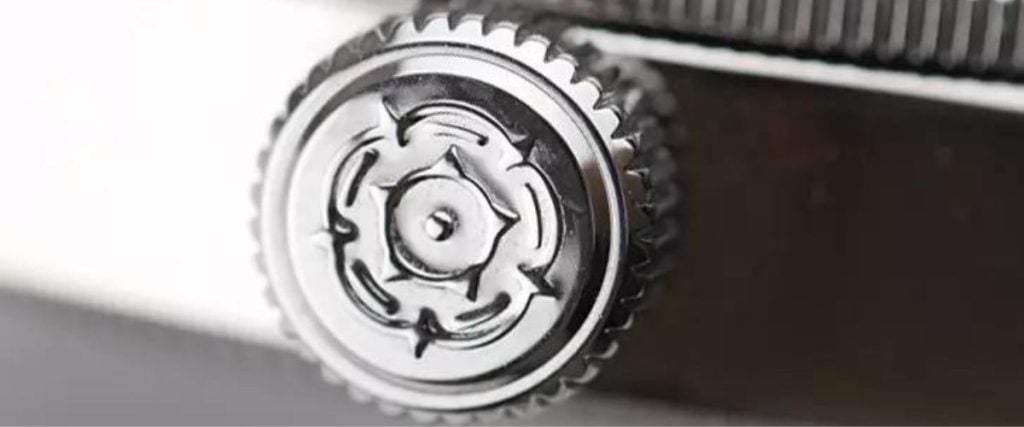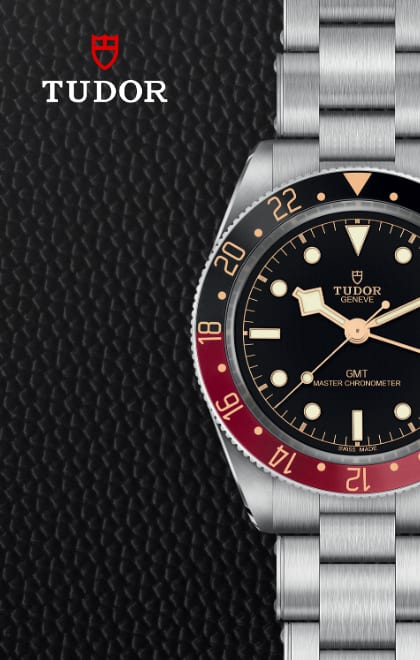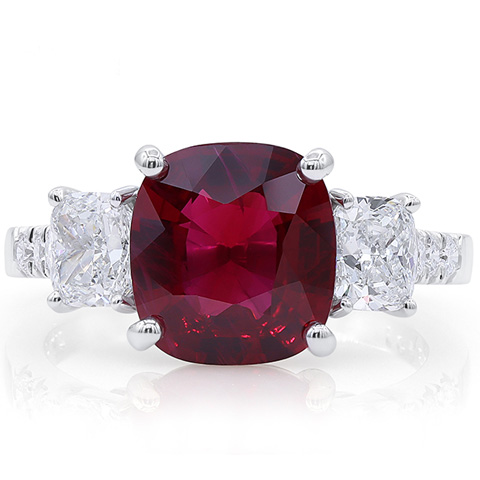
What is a Watch Crown and Why is it important?
Have you recently read the term “watch crown” as part of a timepiece’s specifications or review and wondered what this means? Or have you just found yourself staring at your watch, speculating what that little knob on the side is?
Trust me, you’re not alone. We’ve all wondered what this component is called at some point. This charming feature is called a watch crown, and it’s not just for show.
A watch crown is the often small, rounded button-like feature on your watch case’s side. Its primary job is to help wind the watch – if your watch has a mechanical movement – and to set the time on the dial.
This information might be nothing new to you, but did you know that crowns offer more than just winding and setting? In today’s blog, we will be exploring all the intricacies of a watch crown, including the different types of watch crowns out there and why they are so important in the construction of your timepiece.
Why are Crowns so Important?
The humble watch crown might seem like a small, insignificant detail at first, but it actually provides a long list of benefits to your timepiece. Usually found on the right-hand side of the case but also sometimes positioned on the left (we’re looking at you U-Boat), the watch crown is predominantly used for setting the time and date on your watch.
By popping it out to its correct position, you can turn the crown to adjust the hands and calendar. And, if your watch has additional complications—like a moon phase or GMT—the crown handles those settings too.
If you have a mechanical watch, the crown is also essential in winding the movement. Unlike quartz watches that are powered by an electronic battery, mechanical movements rely on a mainspring to store energy. When you turn the crown, it tightens this mainspring, gradually releasing energy that powers the watch.
Moreover, the watch crown plays a protective role in the functionality of your timepiece. Some crowns have a screw-down feature, creating a tight seal between the crown and case. This helps to protect the watch, and the movement inside, from things like water, dust, and dirt. It’s a particularly vital feature for those wanting a watch to use for diving or outdoor adventures.
History of Watch Crowns

In the early days of watchmaking history, people had yet to experience the joy of wearing a wristwatch. Instead, they typically kept a pocket watch in their pocket and held it onto their clothing with a chain.
With their manual winding movements, these devices required winding once or twice a day to keep their time. But they didn’t have a crown that could do that. Instead, the owner would have to carry around a small winding key, which was placed into a small hole in the side of the case. They would then have to turn the key to wind their pocket watch.
This was the case until the early 19th century when a clever chap named Adolphe Nicole introduced the first watch crown. His invention replaced those fiddly keys with a much simpler, integrated knob on the side of the watch case. It was a revolutionary innovation, allowing watch owners to wind their timepieces up on the go – with no more risk of losing those small winding keys!
Ever since, watch crowns have evolved to become more than just a winding tool. In the 20th century, watchmakers started adding features like screw-down crowns for better water resistance, and the integration of more complex complications like GMT and perpetual calendar allowed crowns to manipulate these features, too.
The look of watch crowns has also changed over the years. They were once large and onion-shaped but have now adapted to become smaller and sleeker. Their style is tailored to different types of watches, ensuring the crown not only serves its practical purpose but also complements the overall aesthetic of the watch.
Types of Watch Crowns
When it comes to watch crowns, there’s more variety than you might think! Each type of crown has its own unique set of features and serves specific functions, adding both style and practicality to your timepiece. Let’s take a look at some of the most popular types of watch crowns you might find…
Push-Pull Crown
Possibly the most common and straightforward type of watch crown you’ll encounter is the push-pull crown. As its name suggests, it uses a simple pull and push mechanism. To set the date or wind the movement, you simply pull the crown outward – often to different positions for each function.
Then once the movement is fully wound and the time and date are set correctly, you push the crown back in to secure the settings. Push-pull crowns are found in most everyday watches, especially dress watches that don’t require high levels of water resistance.
Screw-Down Crown
Most often found on diving watches and adventure watches, the screw-down crown arrives with a clever threaded mechanism that literally allows the crown to be screwed into the watch case. This creates a tight seal against the two components so you can feel assured of enhanced water resistance and protection against dust and debris.
To adjust the crown or manually wind the movement, you would unscrew the crown before screwing it back in. Screw-down crowns are essential for watches designed for extreme conditions, especially diver’s watches that need complete protection against water pressure.
Onion-Shaped Crowns
While the two types of watch crowns above reflect the functionality of the watch, the next few crowns are named as such for their looks. The onion-shaped crown is exactly what its name suggests: a crown that looks a lot like an onion.
It has an almost bulbous appearance reminiscent of the shape of some of the first watch crowns. As such, they are a popular sight on vintage-inspired watches. They add a real nostalgic charm to watches, plus their large size and knurled detailing make them easy to grip and adjust.
Crowns with Cabochon
Cabochon crowns are a popular choice for those that want their watch to look elegant and stylish. It’s a style that sees the tip of the crown set with a cabochon gemstone, a gemstone that is smooth and rounded for a sophisticated look.
The Cartier Tank is one of the world’s most famous watches known for boasting a cabochon crown on the right hand side of its rectangular case. The cabochon is usually made from materials like sapphire, ruby, or onyx and not only enhances the watch’s aesthetics but also provides a tactile, satisfying feel.
Recessed Crowns
The recessed crown is a type of crown that is fairly new to the watch world, spotted on modern watches. Unlike traditional crowns that protrude from the watch case, these knobs are embedded or set into a small cavity within the case. They are designed to enhance protection, so you are less likely to damage the crown should you knock it against a hard surface.
Explore the
Biggest Pre-Owned Collection of Luxury Watches
Plus, it also helps to maintain a watch’s water resistance and gives the case a more streamlined appearance. You’ll most likely see recessed crowns in sports watches where durability and sleek design are key.
When Does a Watch Crown Need Replacement?
Hopefully, your watch crown will never need replacing, but if it becomes damaged, hard to operate, or the water resistance is compromised, it may require a replacement. Common signs of a broken watch crown include difficulty winding the watch, problems setting the time, or noticeable wear and tear on the exterior of the crown.
Replacing a watch crown yourself isn’t an easy task, as it’s an intricate process that requires a steady hand and plenty of precision. The method involves removing the old crown, selecting the correct replacement, and then carefully ensuring it fits perfectly against the case and attaches to the movement to ensure all functions operate correctly. It often requires specialized tools and expertise to avoid damaging the watch and the movement inside.
For the best results, we advise you to leave crown replacement to professional watchmakers. At Exquisite Timepieces, we offer a specialized watch repair service where we make sure only the top watchmakers handle and repair your timepiece. We securely package each watch and send it directly to authorized service facilities to ensure it’s treated with the utmost care.
Conclusion
If you couldn’t tell, we think the crown is a bit of a hidden gem. It may seem like a small, barely noticeable part of a watch, but it plays a critical role in its functionality. From winding the movement to setting the time to shielding the watch against water, dust, and debris, the crown is essential for your watch’s performance and longevity.
And given its importance, it’s equally important to make sure you take care of your watch crown. If you suspect any damage or issues, we highly recommend having it inspected immediately to prevent any further harm coming to your precious timepiece.
About Exquisite Timepieces
Established in 1998, Exquisite Timepieces is your one-stop shop for all things luxury watches! We are an authorized dealer for 60+ luxury watch brands including Omega, Hublot, Seiko, & Longines! We are proud to showcase one of the world’s largest pre-owned watch collections, including renowned brands like Rolex and Patek Philippe. Check out our brand new watch arrivals here and popular pre-owned listings here.



















